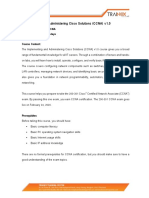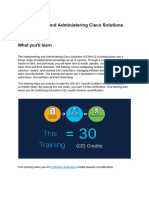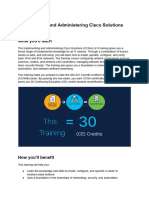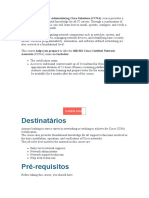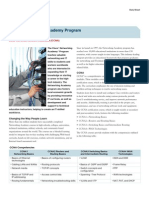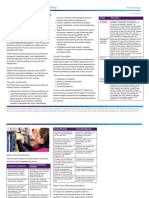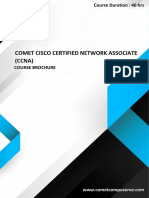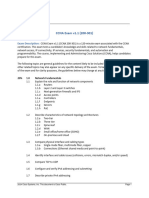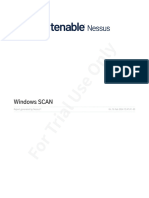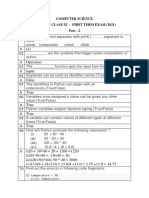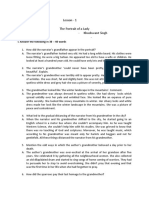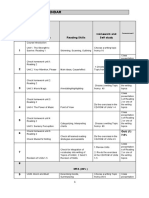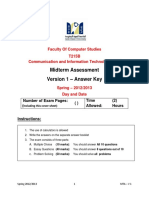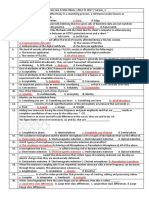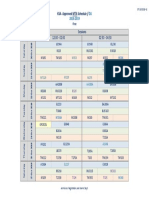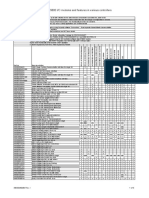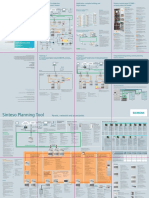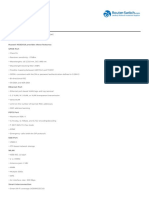COURSE OUTLINE: CI-CCNA
Implementing and Administering Cisco Solutions
Course Name CI-CCNA
Implementing and Administering Cisco Solutions
Course Duration 5 Days
Course Structure Instructor-Led
Course Overview The Implementing and Administering Cisco Solutions
(CCNA) v1.0 course gives you a broad range of
fundamental knowledge for all IT careers. Through a
combination of lecture, hands-on labs, and self-study,
you will learn how to install, operate, configure, and verify
basic IPv4 and IPv6 networks. The course covers
configuring network components such as switches,
routers, and wireless LAN controllers; managing network
devices; and identifying basic security threats. The
course also gives you a foundation in network
programmability, automation, and software-defined
networking.
The Cisco® Solutions: Implementation and
Administration (CCNA 200-301) course builds on your
existing user-level knowledge and experience with
computing and networking to provide you with the
knowledge and skills expected of an entry-level network
administrator. It also addresses the content described in
the exam objectives for the Certified Cisco Network
Administrator (CCNA® 200-301). If you are pursuing a
Cisco technical certification path, the CCNA 200.301
exam is your first step into the world of Cisco
certification.
Audience Profile
● Entry-level network engineer
● Network administrator
● Network support technician
● Help desk technician
Prerequisites
Before taking this course, you should have:
● Basic computer literacy
● Basic PC operating system navigation skills
● Basic Internet usage skills
● Basic IP address knowledge
To ensure your success in this course, you should have
experience with computer user skills, including the ability
to complete tasks in a Microsoft Windows environment
and the ability to search for and access information on
the Internet. You can obtain this level of skill and
Page 1 of 5
� COURSE OUTLINE: CI-CCNA
Implementing and Administering Cisco Solutions
knowledge by taking one of the following Logical
Operations courses:
• Introduction to Personal Computers Using
Microsoft® Windows® 10
• Using Microsoft® Windows® 10
• Microsoft® Windows® 10: Transition from
Windows® 7
You should also have intermediate knowledge of
computing and networking concepts. Any type of
technology or system administration training or
certification, or experience working in an IT environment,
is strongly recommended. For instance, other industry
certifications such as CompTIA®'s ITF+®, A+®, or
Network+® may be especially helpful for students who
are preparing for the CCNA 200-301 exam.
Course Outcome After completing this course, students will be able
to:
• Identify the components of a computer network and
describe their basic characteristics
• Understand the model of host-to-host communication
• Describe the features and functions of the Cisco
Internetwork Operating System (IOS) software
• Describe LANs and the role of switches within LANs
• Describe Ethernet as the network access layer of
TCP/IP and describe the operation of switches
• Install a switch and perform the initial configuration
• Describe the TCP/IP Internet layer, IPv4, its
addressing scheme, and subnetting
• Describe the TCP/IP Transport layer and Application
layer
• Explore functions of routing
• Implement basic configuration on a Cisco router
• Explain host-to-host communications across
switches and routers
• Identify and resolve common switched network
issues and common problems associated with IPv4
addressing
• Describe IPv6 main features and addresses, and
configure and verify basic IPv6 connectivity
• Describe the operation, benefits, and limitations of
static routing
• Describe, implement, and verify Virtual Local Area
Networks (VLANs) and trunks
• Describe the application and configuration of inter-
VLAN routing
• Explain the basics of dynamic routing protocols and
describe components and terms of Open Shortest
Page 2 of 5
� COURSE OUTLINE: CI-CCNA
Implementing and Administering Cisco Solutions
Path First (OSPF)
• Explain how Spanning Tree Protocol (STP) and
Rapid Spanning Tree Protocol (RSTP) work
• Configure link aggregation using EtherChannel
• Describe the purpose of Layer 3 redundancy
protocols
• Describe basic WAN and VPN concepts
• Describe the operation of Access Control Lists
(ACLs) and their applications in the network
• Configure Internet access using Dynamic Host
Configuration Protocol (DHCP) clients and explain
and configure Network Address Translation (NAT) on
Cisco routers
• Describe basic Quality of Service (QoS) concepts
• Describe the concepts of wireless networks, which
types of wireless networks can be built, and how to
use Wireless LAN Controllers (WLCs)
• Describe network and device architectures and
introduce virtualization
• Introduce the concept of network programmability
and Software-Defined Networking (SDN) and
describe smart network management solutions such
as Cisco DNA Center, Software-Defined Access (SD-
Access), and Software-Defined Wide Area Network
(SD-WAN)
• Configure basic IOS system monitoring tools
• Describe the management of Cisco devices
• Describe the current security threat landscape
• Describe threat defense technologies
• Implement a basic security configuration of the
device management plane
• Implement basic steps to harden network devices
Course Details Lesson 1: Networking Fundamentals
Topic A: Network Types
Topic B: Network Components
Topic C: Network Topologies
Topic D: Network Models
Topic E: Basic Networking Protocols
Topic F: Transmission Media and Connectors
Topic G: Introduction to Cisco Networks and Cisco IOS
Commands
Lesson 2: Configuring Switching
Topic A: Switching Concepts
Topic B: Configure Basic Switch Operation
Topic C: Configure VLANs
Topic D: Configure Interswitch Connectivity
Page 3 of 5
�COURSE OUTLINE: CI-CCNA
Implementing and Administering Cisco Solutions
Lesson 3: Configuring IP Addressing
Topic A: Configure IPv4 Addresses
Topic B: Configure IPv4 Subnets
Topic C: Configure IPv6 Addresses
Topic D: Manage Network Addressing
Lesson 4: Configuring Routing
Topic A: Routing Basics
Topic B: Interpret Routing Tables
Topic C: Configure Static Routing
Topic D: Configure Dynamic Routing
Lesson 5: Configuring Wireless Connectivity
Topic A: Wireless LANs
Topic B: Manage WLAN Connections
Topic C: Configure Clients for WLAN Access
Lesson 6: Configuring IP Network Services
Topic A: IP Network Services
Topic B: Configure DHCP
Topic C: Configure NAT
Topic D: Configure NTP
Topic E: Configure DNS
Topic F: Perform Network Management
Lesson 7: Security Fundamentals
Topic A: Security Concepts
Topic B: Manage Passwords
Topic C: Configure Layer 2 Security
Topic D: Configure Wireless Security
Topic E: Remote Access Security
Lesson 8: Automation and Programmability
Topic A: Automation, Network Management, and
Device Management
Topic B: Controller-Based Networking and Software-
Defined Networking
Topic C: Programmability Concepts
Lesson 9: Troubleshooting Network Issues
Topic A: Troubleshooting Methodologies
Topic B: Troubleshoot Interface and Cable Issues
Topic C: Troubleshoot Switching Issues
Page 4 of 5
�COURSE OUTLINE: CI-CCNA
Implementing and Administering Cisco Solutions
Topic D: Troubleshoot IPv4 and IPv6 Addressing
Issues
Topic E: Troubleshoot Routing Issues
Topic F: Troubleshoot WLAN Issues
Topic G: Troubleshoot Network Services Issues
Topic H: Troubleshoot Network Management Issues
Topic I: Troubleshoot Security Issues
Associated Certification & Exam
This course helps you prepare to take the 200-301
Cisco Certified Network Associate (CCNA) exam. By
passing this one exam, you earn CCNA certification.
Page 5 of 5







